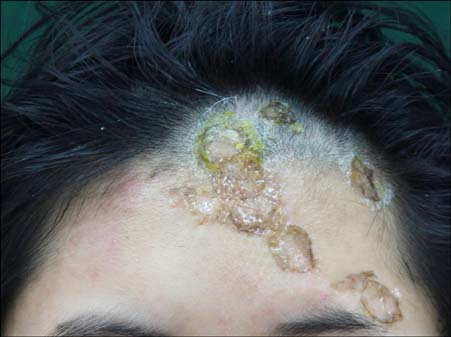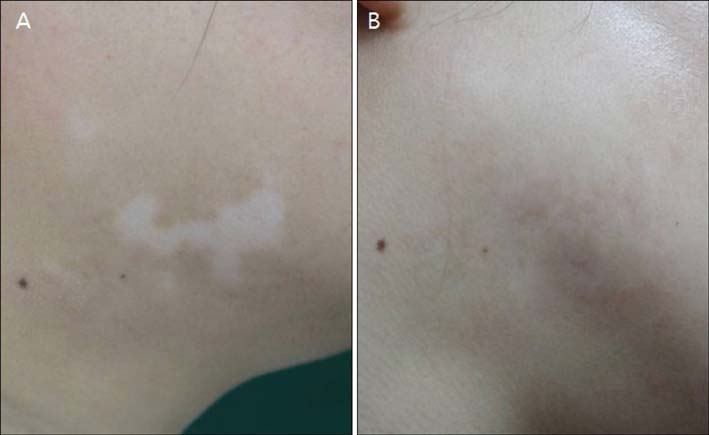Ann Dermatol.
2014 Dec;26(6):751-754. 10.5021/ad.2014.26.6.751.
Fibrin Glue Fixation for Suction Blister Epidermal Grafting in Two Patients with Stable Vitiligo
- Affiliations
-
- 1Department of Dermatology, Busan Paik Hospital, Inje University College of Medicine, Busan, Korea. derma09@hanmail.net
- KMID: 2264873
- DOI: http://doi.org/10.5021/ad.2014.26.6.751
Abstract
- Vitiligo is a chronic disorder characterized by depigmented macules which can slowly enlarge with the concurrent development of new lesions. Although autologous suction blister epidermal grafting is an established technique for the treatment of recalcitrant, stable vitiligo, the donor tissue graft is not easy to fix at the recipient site, especially in areas such as the joints, face, cutaneous folds, hands, feet, and hair-bearing areas. Therefore, various methods of donor tissue fixation have been attempted. We report two cases of vitiligo treated with suction blister epidermal grafting, with fibrin tissue adhesion. The first case is that of 16-year-old female patient presented with hypopigmented patches on the forehead and frontal scalp area. The other case is that of 32-year-old female patient presented with hypopigmented patches on the chin. We treated them with phototherapy for 1~4 years; however, the lesions were recalcitrant. Therefore, we tried treatment with a suction blister epidermal graft. Because graft fixation is difficult at the recipient sites, fibrin glue was sprayed on the grafts. Thereafter, we applied a porous silicone wound contact layer over the graft area and applied sterile gauze dressing that was left for a week. One week after the procedure, firm fixation of the donor tissue was observed in both cases. Fibrin glue seemed to improve the graft fixation, providng protection against infection and an optimal environment for wound healing. This report suggests that the application of an epidermal graft with fibrin glufixation, can provide the best result in the surgical treatment of stable vitiligo.
Keyword
MeSH Terms
Figure
Reference
-
1. Felsten LM, Alikhan A, Petronic-Rosic V. Vitiligo: a comprehensive overview Part II: treatment options and approach to treatment. J Am Acad Dermatol. 2011; 65:493–514.2. Njoo MD, Westerhof W, Bos JD, Bossuyt PM. A systematic review of autologous transplantation methods in vitiligo. Arch Dermatol. 1998; 134:1543–1549.
Article3. Kim HJ, Lee MH. Autologous epidermal grafting in treatment of vitiligo: evaluation for its effectiveness and patient satisfaction. Korean J Dermatol. 2003; 41:287–292.4. Currie LJ, Sharpe JR, Martin R. The use of fibrin glue in skin grafts and tissue-engineered skin replacements: a review. Plast Reconstr Surg. 2001; 108:1713–1726.
Article5. Sportnitz SD. Fibrin sealant: past, present, and future: A brief review. World J Surg. 2010; 34:632–634.
Article6. Li J, Fu WW, Zheng ZZ, Zhang QQ, Xu Y, Fang L. Suction blister epidermal grafting using a modified suction method in the treatment of stable vitiligo: a retrospective study. Dermatol Surg. 2011; 37:999–1006.
Article7. Ko WC, Chen YF. Suction blister epidermal grafts combined with CO2 laser superficial ablation as a good method for treating small-sized vitiligo. Dermatol Surg. 2009; 35:601–606.
Article8. Olsson MJ, Juhlin L. Epidermal sheet grafts for repigmentation of vitiligo and piebaldism, with a review of surgical techniques. Acta Derm Venereol. 1997; 77:463–466.9. Kahn AM, Cohen MJ. Repigmentation in vitiligo patients. Melanocyte transfer via ultra-thin grafts. Dermatol Surg. 1998; 24:365–367.10. Suvanprakorn P, Dee-Ananlap S, Pongsomboon C, Klaus SN. Melanocyte autologous grafting for treatment of leukoderma. J Am Acad Dermatol. 1985; 13:968–974.
Article11. Skouge J, Morison WL. Vitiligo treatment with a combination of PUVA therapy and epidermal autografts. Arch Dermatol. 1995; 131:1257–1258.
Article12. Kim SE, Kim JR, Kim TH. The comparative study of the epidermal graft by suction blister between simple and complicated cases of vitiligo. Korean J Dermatol. 2003; 41:716–721.13. Oh SH, Shin JY, Kim T, Kim do Y, Park SG, Hann SK. Dressing-free epidermal grafting for the treatment of perioral vitiligo. Dermatol Surg. 2011; 37:1173–1175.
Article14. Radosevich M, Goubran HI, Burnouf T. Fibrin sealant: scientific rationale, production methods, properties, and current clinical use. Vox Sang. 1997; 72:133–143.
Article15. Vedung S, Hedlung A. Fibrin glue: its use for skin grafting of contaminated burn wounds in areas difficult to immobilize. J Burn Care Rehabil. 1993; 14:356–358.
Article
- Full Text Links
- Actions
-
Cited
- CITED
-
- Close
- Share
- Similar articles
-
- Surgical interventions for vitiligo
- Autologous Suction Blister Grafting for the Treatment of Vitiligo
- Autologous Epidermal grafting in Treatment of Vitiligo: Evaluation for Its Effectiveness and Patient Satisfaction
- Four Cases of Focal Vitiligo Treated by Suction Blistered Epidermal Graft Using a Suction Device with Intrinsic Heating System
- The Efficacy of Autologous Epidermal Grafting Based on Clinical Types for the Treatment of 320 Stable Vitiligo Lesions





